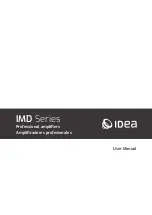
EN
6
DATAPORTS
The DataPort connects to optional QSC accessories and processing devices. DataPort
devices provide remote Standby control, monitoring, DSP processing, filter and crossover
functions.
The CX108V DataPort supports the full "V1" Dataport feature set. Due to the limited space,
it is not possible to mount Dataport accessories directly onto the chassis. Up to four
accessory modules may be connected with Dataport cables.
Each DataPort connects to its respective channel pair; Ch.1-2, Ch.3-4, Ch.5-6, and Ch.7-8
Each channel pair may use its Dataport or the Terminal Block inputs. When using the
Dataport, do not connect to that channel's Terminal Block inputs.
Amplifier Standby is controlled only by the Ch.1- 2 DataPort.
DataPort Tips:
1- Dataport 1-2 controls Standby for the entire amplifier. The AC switch must be turned
ON before the Dataport can control the power.
2- Each Dataport controls and monitors the signals to its respective channel pair (Ch.1-2,
Ch.3-4, Ch.5-6, or Ch.7-8).
3- Do not use the Bridge Mono or Parallel mode switches when using Dataport Inputs. The
signal level may be reduced. For more information, see the Owner's Manual for the Dataport device.
4- A Dataport device is normally used to control the signal Gain before entering the amplifier. After confirming correct operation at
reduced Gain, set the front panel Gain controls at maximum. If desired, install the protective cover to prevent tampering.
5- In rare cases, the Dataport may be used only for monitoring the amplifier. Signals may be connected to the Terminal Block inputs, and
will over-ride any input signals from the Dataport connection.
6- Each channel pair uses a single internal heat sink. The heat sink temperatures are reported on that pair's DataPort. To monitor all
four heat sink temperatures, all four DataPorts must be connected to the monitoring device.
7- Consult your QSC dealer or the QSC web site for the latest Dataport products.
OUTPUTS
Wiring connections are shown on the back of the chassis. STEREO and PARALLEL connections are shown on the left side, and BRIDGE
mode is shown on the right side. Carefully note the polarity marks, which are arranged to make Bridge Mode connections easier.
OUTPUT TERMINAL SAFETY WARNING! Do not
touch output terminals while amplifier power is on.
Make all connections with amplifier turned off. Risk
of hazardous energy!
Stereo and Parallel Mode-
Connect each 70V circuit to its own channel
of the amplifier, as shown on the left side of the chassis label. The mode
configuration switches, page 5, must be set for Stereo or Parallel mode.
70V Output- Risk of hazardous energy! Class 2 wiring
shall be used for 70V outputs.
Bridge Mode-
Bridge mode configures the selected channel pair to
drive a single 140V audio circuit. See page 5 to set the Bridge Mode
switches. Connect the load as shown on the right side of the chassis
label. Connect only 140V distributed audio circuits in bridged mode. Use
Stereo or Parallel mode channels to drive 70V loads. BRIDGE MODE PRE-
CAUTIONS: Do not use 70V loads in bridge mode! 140V is the minimum
for bridge mode operation.
140V Output (Bridged Mode)- Class 3 Wiring shall be
used for bridged mono 140V outputs.
70V stereo or parallel
connection- Each 70V
zone connects to its
respective channel.
Ensure that all
speaker connections
maintain proper
polarity.
140V Bridge connec-
tion- Wire each
bridged pair to a 140V
circuit as shown.
Check for proper
polarity.
Содержание CX108V
Страница 36: ...CH 36 IEC CX108V 2 2 Ch 1 2 Ch 3 4 Ch 5 6 Ch 7 8 LF 1 10 QSC...
Страница 37: ...CH 37 140V p 38 12dB 70V 50 Hz 75 Hz 3 12k 6k 600 6 mm 4 5 6 7 4 5 6 7 4 5 6 7 LF 2 3 8 9 3 8 LF 2 9 50Hz 75 Hz...
Страница 39: ...CH 39 LED INDICATORS LED LED LED 1 2 LED LED LED 35 dB LED LED LED LED LED LED 5 LED CX108V LED Ch 1 Ch 2...
Страница 40: ...CH 40 35 dB 1 26V 70V dB 21 14 1 dB 14 dB LED 1 9 64 3 5 mm 2 3 4 LED CX108V LED Ch 1 Ch 2...
Страница 42: ...This page intentionally blank...
Страница 43: ...This page intentionally blank...







































